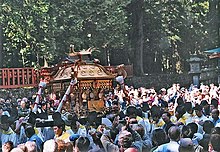This article's tone or style may not reflect the encyclopedic tone used on Wikipedia. (November 2023) |
Shinko-shiki (


The prominent feature of the procession involves a group of participants who proceed either on foot or through various modes of transportation along a predetermined route. These parades necessitate organizational efforts and resources, commonly arranged as integral components of a shrine's ceremonial or associated endeavors.[15]
This festival may occur on both land and water, with the route and destinations typically adhering to established traditions. Costumes and specific rituals often feature as part of the festivities. Occasionally referred to as "O-watari," (お
The Gion Matsuri held at Yasaka Shrine serves as a well-known illustration of the Shinko-sai ritual.[8][16]
Shinko-shiki is primarily linked with the Kami's visitation to its adherents, although interpretations and ceremonial practices can vary significantly.[15]
For example, the Tokyo Shinko-shiki tends to be lively with a focus on revelry and alcohol consumption, whereas in Yuzawa, it is characterized by a more subdued and formal atmosphere.[15]
References
edit- ^ Sanmi, Sasaki (2011-10-18). Chado the Way of Tea: A Japanese Tea Master's Almanac. Tuttle Publishing. ISBN 978-1-4629-0036-7.
- ^ Plutschow, Herbert (2013-11-05). Matsuri: The Festivals of Japan: With a Selection from P.G. O'Neill's Photographic Archive of Matsuri. Routledge. ISBN 978-1-134-24698-4.
- ^ Cali, Joseph; Dougill, John (2012-11-30). Shinto Shrines: A Guide to the Sacred Sites of Japan's Ancient Religion. University of Hawaii Press. ISBN 978-0-8248-3775-4.
- ^ McVeigh, Brian J. (2014-07-11). Interpreting Japan: Approaches and Applications for the Classroom. Routledge. ISBN 978-1-317-91304-7.
- ^ Changing World Religions, Cults & Occult. Jerry Stokes.
- ^ Japan, Asiatic Society of (1935). Transactions of the Asiatic Society of Japan. The Society.
- ^ The New Encyclopaedia Britannica: Macropaedia : Knowledge in depth. Encyclopaedia Britannica. 1998. ISBN 978-0-85229-663-9.
- ^ a b c d "Shinkôshiki,O-neri,O-watari |
國學院大學 デジタルミュージアム". - ^ Hirayama, Miyuki (2001). Matsuri in Shimomura: Experience, Performance, and History in a Japanese Festival. Indiana University.
- ^ Basic Terms of Shinto. (The Association of Shinto Shriners) Kokugakuin University, Institute for Japanese Culture and Classics. 1958.
- ^ Littleton, C. Scott (2002). Shinto: Origins, Rituals, Festivals, Spirits, Sacred Places. Oxford University Press. ISBN 978-0-19-521886-2.
- ^ Coogan, Michael David; Narayanan, Vasudha (2005). Eastern Religions: Origins, Beliefs, Practices, Holy Texts, Sacred Places. Oxford University Press. ISBN 978-0-19-522190-9.
- ^ Eastern Horizon. Eastern Horizon Press. 1964.
- ^ a b "Shinkō-sai | Britannica". www.britannica.com. Retrieved 2023-04-11.
- ^ a b c d Ashkenazi, Michael (1993-03-01). Matsuri: Festivals of a Japanese Town. University of Hawaii Press. ISBN 978-0-8248-1421-2.
- ^ "The Root of the Gion Matsuri: The Shinko Matsuri – EBISU
恵比壽 日 藥 直送 ". ebisujapan.com. Retrieved 2023-05-21.